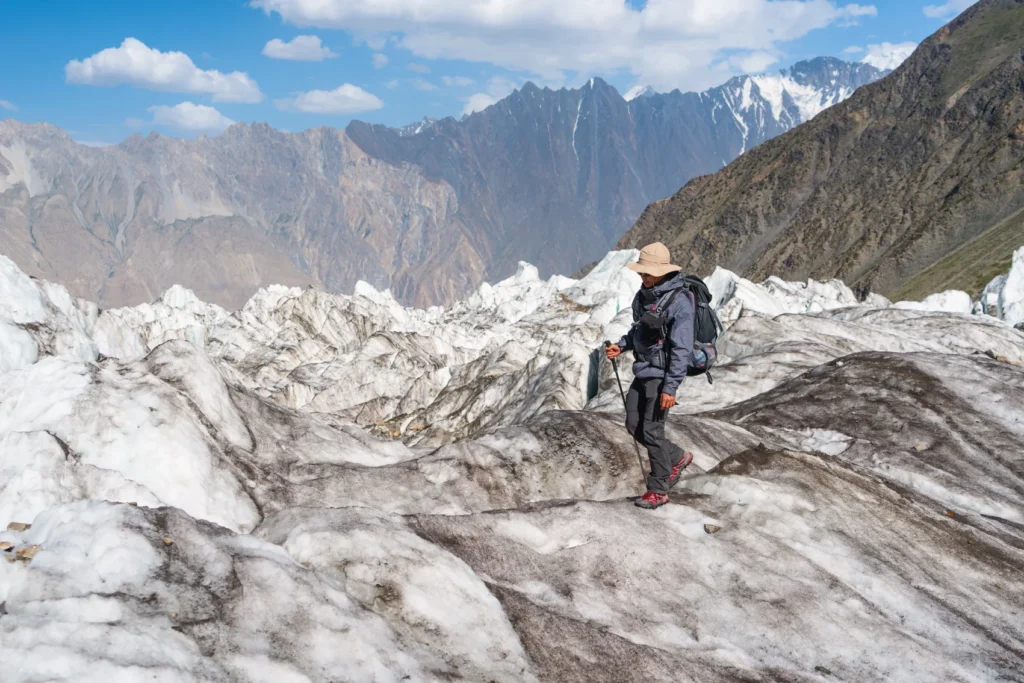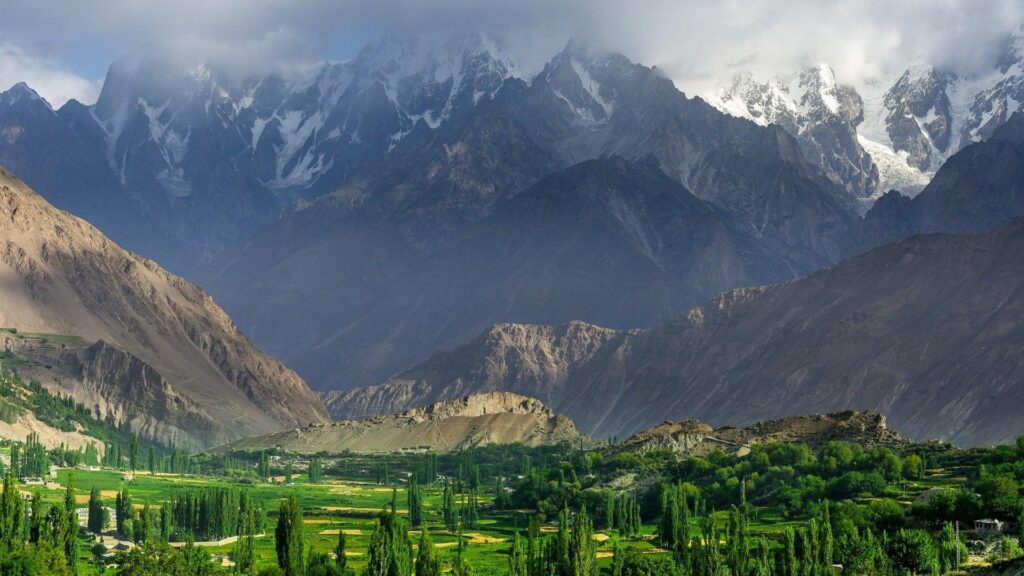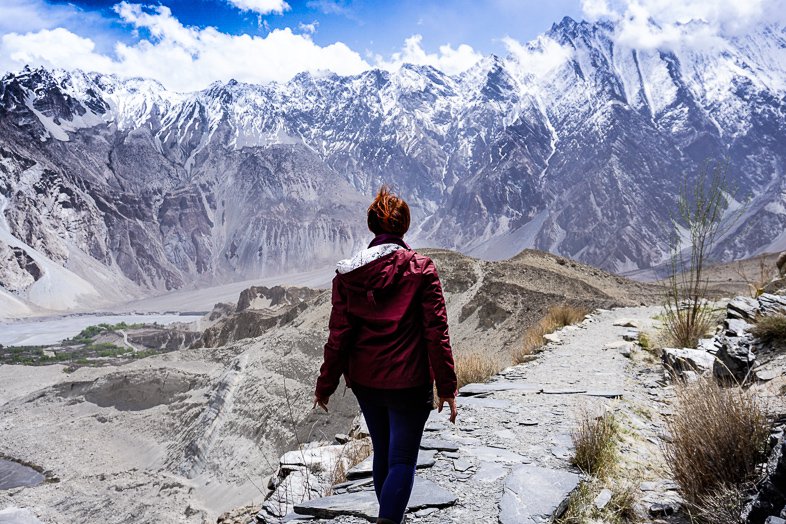
“Pakistan vs Nepal: Which is the Better Trekking Destination?”
1. Natural Scenery and Landscapes

Pakistan
- Topography: Home to the Karakoram, Himalayas, and Hindu Kush ranges.
- Famous Peaks: K2 (2nd highest in the world), Nanga Parbat, Rakaposhi.
- Unique Features: Untouched wilderness, alpine lakes (Rush Lake, Ratti Gali), massive glaciers (Baltoro, Batura).
- Diversity: From lush meadows of Fairy Meadows to the harsh, icy expanses of Concordia.
Nepal
- Topography: Dominated by the Himalayan Range.
- Famous Peaks: Mount Everest, Annapurna, Lhotse, Makalu.
- Unique Features: Iconic base camps, rolling hills, dense rhododendron forests.
- Diversity: Terraced farmlands to snowy Everest regions.
Winner: Tie — Both countries offer unparalleled and diverse mountain scenery.
2. Trekking Routes
Pakistan
- K2 Base Camp Trek
- Fairy Meadows to Nanga Parbat Base Camp
- Rush Lake Trek
- Batura Glacier Trek
Specialty: Raw, less crowded, more exploratory.
Nepal
- Everest Base Camp Trek
- Annapurna Circuit Trek
- Langtang Valley Trek
- Manaslu Circuit Trek
Specialty: Well-marked, guesthouses on trails, popular with international trekkers.
Winner: Nepal for infrastructure; Pakistan for pure wilderness.
3. Accessibility & Travel Convenience

Pakistan
- Requires visas for most foreigners.
- Long drives (Karakoram Highway) or domestic flights (Gilgit, Skardu).
- Infrastructure improving but limited in remote areas.
Nepal
- Visa on arrival for many countries.
- Kathmandu is a global trekking hub.
- Easy domestic flights and bus systems.
Winner: Nepal — easier entry and trail access.
4. Trekking Difficulty

Pakistan
- More rugged and challenging.
- Requires self-sufficiency or guides.
- Long isolation from civilization.
Nepal
- Varying difficulty; EBC moderate for fit hikers.
- Lodges, food, and help available throughout.
Winner: Pakistan — for experienced trekkers; Nepal — for all skill levels.
5. Cost Comparison
| Expense | Pakistan (USD) | Nepal (USD) |
|---|---|---|
| Visa Fee | 50 – 100 | 25 – 50 |
| Domestic Travel | 100 – 300 | 50 – 100 |
| Trekking Permits | 100 – 300 | 30 – 50 |
| Accommodation (Per Night) | 10 – 30 | 5 – 20 |
| Food (Per Day) | 15 – 25 | 10 – 20 |
| Guide/Porter Fee (Per Day) | 30 – 50 | 20 – 30 |
Winner: Nepal — Slightly cheaper and budget-friendly.
6. Safety & Political Stability
Pakistan
- Safety improved in Gilgit-Baltistan.
- Permits needed for some treks.
- Caution advised near borders.
Nepal
- Stable trekking environment.
- Occasional weather disruptions.
- No political unrest in trek zones.
Winner: Nepal — More established safety for tourists.
7. Cultural Experience
Pakistan
- Unique blend: Balti, Wakhi, and Shina cultures.
- Less touristy, more authentic interactions.
- Local hospitality unmatched.
Nepal
- Rich Buddhist and Hindu traditions.
- Teahouse culture: meet trekkers from around the world.
- Festivals, temples, and rituals add cultural depth.
Winner: Tie — Both rich in culture but in different ways.
8. Environmental Concerns
Pakistan
- Minimal tourist impact so far.
- Risks of plastic pollution increasing.
Nepal
- Over-tourism in EBC and Annapurna regions.
- Waste management is a growing issue.
Winner: Pakistan — More pristine, but fragile.
9. Popularity & Global Recognition
Pakistan
- Gaining fame post-2018 tourism drive.
- Still less visited globally.
Nepal
- Globally recognized for trekking.
- Regularly featured in international travel media.
Winner: Nepal — Trekking capital of the world.
10. Verdict: Which is Better?
| Category | Winner |
| Scenery | Tie |
| Trekking Routes | Tie |
| Accessibility | Nepal |
| Difficulty | Depends on preference |
| Cost | Nepal |
| Safety | Nepal |
| Culture | Tie |
| Environment | Pakistan |
| Popularity | Nepal |
Final Verdict:
- For Adventure, Solitude & Raw Nature: Pakistan
- For Convenience, Community & Variety: Nepal
11. Suggested Itineraries
Pakistan 7-Day Sample Itinerary:
- Day 1: Islamabad to Gilgit
- Day 2: Drive to Raikot Bridge
- Day 3–4: Nanga Parbat Base Camp Trek
- Day 5: Rest/Explore Fairy Meadows
- Day 6: Return to Gilgit
- Day 7: Flight to Islamabad
Nepal 7-Day Sample Itinerary:
- Day 1: Kathmandu arrival
- Day 2: Fly to Lukla
- Day 3–6: Everest Base Camp Trek (partial)
- Day 7: Return to Kathmandu
12. Frequently Asked Questions (FAQ)
Q: Is Pakistan safe for foreign trekkers?
A: Yes, especially in Gilgit-Baltistan. Use guides for remote treks.
Q: Which destination is cheaper overall?
A: Nepal offers budget-friendly options; Pakistan slightly higher due to logistics.
Q: Which offers more solitude?
A: Pakistan — fewer tourists, wilder trails.
Conclusion
Pakistan and Nepal both offer world-class trekking experiences — but cater to slightly different adventurers. If you seek raw, untamed landscapes and cultural authenticity, Pakistan may win your heart. But if you prefer ease of travel, safety, and community, Nepal stands as the ultimate trekking paradise. Either way, your trek will be unforgettable.

11 Responses
Nice
wow nice
nice information
F good
wow
Awsome
this information is very helpful
nice info
ejwvvneuqpsmacn,ew
send me your Watsaap
this information is too good